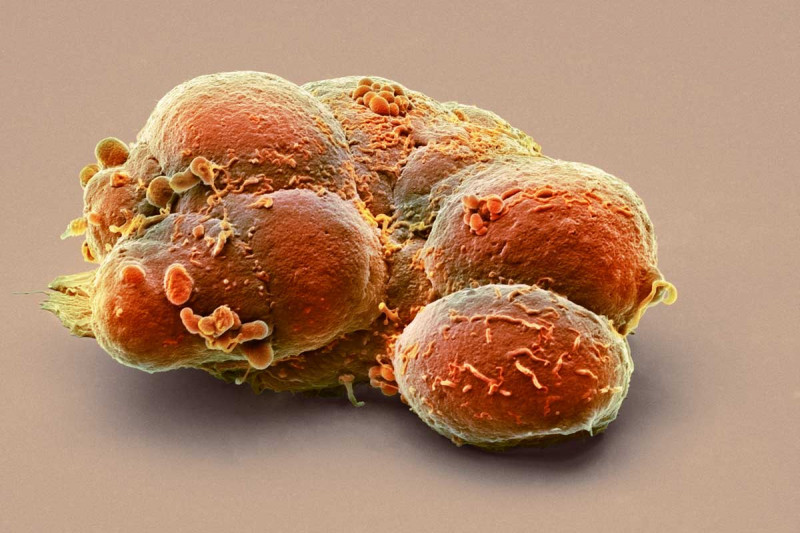
Pluripotent stem cells are able to develop into any cell type in the human body. This ability makes them a potential source of cells to repair damaged tissue.
In some ways, stem cells get their power from being young. In the earliest stages of a developing embryo, stem cells can give rise to all cell types in the body. This unrestricted capacity, called pluripotency, fades as the embryo begins to specialize into more distinct cell types.
Scientists study pluripotent stem cells (PSCs) because they have the potential to generate new cells and restore those that are lost. PSCs can also serve as tools for studying how diseases develop. In the early years of stem cell research, all PSCs were derived from embryos, but in recent years, researchers learned how to turn back the clock and reprogram adult cells to become pluripotent. These are called induced pluripotent stem cells.
“Pluripotent stem cells are very powerful tools in research,” says Daniela Cornacchia, a postdoctoral fellow in the Sloan Kettering Institute laboratory of Lorenz Studer, Director of the Center for Stem Cell Biology at MSK. “Since they will potentially be useful for treating diseases, we want to understand the factors that control how they behave.”
Researchers have tried to understand all the signals that regulate pluripotency so they can make better use of stem cells. But pluripotency itself is complex. In fact, scientists have identified two distinct types: naive and primed. The naive state is developmentally earlier; it is found in mouse PSCs. The primed state is more advanced and developmentally more restricted; it exists in human PSCs isolated by researchers.
Stem cells in the naive state demonstrate more flexibility regarding what cell types they can become. They are less biased toward specific tissues, which makes them easier to control.
Stem cell researchers are trying to capture human PSCs in their naive state to take advantage of their potential for treatments. But this has been surprisingly hard to do, despite using the entire toolbox of current strategies, including some genetic manipulations that might have adverse side effects if used in people.
Now a research team led by Dr. Studer has found a surprisingly simple way to revert human PSCs to a state that is closer to naive pluripotency than conventional human PSCs. All it requires is growing the stem cells in a fat-free culture medium. Merely excluding lipids (a type of fat) from the culture while maintaining all other normal conditions shifts the cells from the primed state to an intermediate state between naive and primed.
The discovery is reported in Cell Stem Cell.
The Best Recipe
“Finding the best possible recipe for a cell medium is essential for creating and inducing the highest quality stem cells for modeling disease and generating cell-replacement therapies,” says Dr. Cornacchia, the study’s first author. “This offers a very simple way to induce a state closer to naive pluripotency, which is stable and very well characterized. There is no need to manipulate genes or proteins, and we had this under our noses all the time!”
In fact, the intermediate pluripotent state can be brought about with a chemically defined human pluripotent stem cell medium called Essential 8TM (E8), which is lipid free. Because of its fully defined and minimal composition, this widely available medium is approved for producing stem cells that can be used in clinical trials.
The research team first noticed that human stem cells grown in E8 perform well when coaxed to differentiate into certain cell types. For example, E8-cultured stem cells are more efficient in producing nerve cells. In a series of experiments, the research team determined that the underlying process behind converting human PSCs toward a naive-like state was the fat-free nature of E8.
“It was remarkable to see how distinct these E8 cells are from conventional human pluripotent stem cells,” Dr. Cornacchia says. “Almost every test we performed showed profound differences across various criteria of pluripotency.”
The discovery that fats affect pluripotency so profoundly came as a surprise. The researchers believe that in a developing embryo, a change in fat levels could cause stem cells to shift from the naive to the primed pluripotent state.
The researchers say the next steps will be to determine which specific fats play a dominant role in regulating pluripotency. They also hope to further clarify how fat levels affect early embryos.
“That such a simple manipulation can have such a far-reaching effect on pluripotency shows us how much is left to discover about this intricate cell state,” Dr. Cornacchia says.




